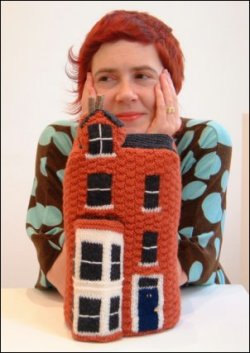 She knits murderer’s houses, and cosies for trees; sweaters with grossly elongated necks, and full body suits pierced with knitting needles; gloves that are joined together at the wrist, and others that are, literally, all thumbs.
She knits murderer’s houses, and cosies for trees; sweaters with grossly elongated necks, and full body suits pierced with knitting needles; gloves that are joined together at the wrist, and others that are, literally, all thumbs.
The imaginative, and startlingly original knitting of British artist, Freddie Robins, can be seen in contemporary art galleries, and permanent museum collections, throughout Europe and the United Kingdom. Her aberrant knitted creations are neither functional, nor useful; nevertheless there is a certain beauty about them. They are technically about as perfect as they can be. She ranks, I suspect, among the best machine knitters in the world.
To really understand her work it helps to visit the London home that she shares with her partner, Ben. Together they have, over the course of a decade, filled the place with their countless collections, and more than a few obsessions. From floor to ceiling, every inch of the home is packed with oddities – religious icons, dolls, taxidermy, fake food, stuffed animals, and toys; lots of toys – all competing with the stuff of ordinary home life. While at first glance it may seem chaotic, the collections are arranged thematically and after a while patterns begin to emerge.
There is a shelf full of horses. A case full of robots. There are pregnant Barbies, and Barbies in wheelchairs, still in their packaging. There is a wall of seascapes, a shriveled-up baby shark found on the beach at Dungeness, and a pair of earrings made out of cod’s ears. There are taxidermy animals, and a gun rack made from tiny, upturned deer hooves. The hooves are polished to a glossy black, and seem to beckon. They’re kind of creepy. Freddie laughs, and assures me that there are worse things upstairs.
On the landing, there’s a wooden cross from Zimbabwe, Mexican Day of the Dead figures, a glittery Dr. Baby Jesus, a collection of rosary beads and a few voodoo dolls. A tiny chest of drawers contains lovingly arrange tableaus of fake severed fingers, glass eyes, and what appear to be religious relics. In the room that functions as an office there is a mummified cat that Freddie and Ben found under the garden shed, and opposite, in a glass display case, a real, stuffed two-headed lamb. Does she know that her home is a bit macabre? “Oh yes,” she says wickedly. “I like the macabre.”
The highlight of the tour is the bedroom – Freddie’s favorite room in the house. The theme is wool, and the room is full of it, in every form imaginable. The curtains are made from woolen army blankets, and are festooned with knitted socks, balaclavas, knitted dolls clothing, and gloves, all of which Freddie has pinned to the blankets. A large glass display box sits on one wall, stuffed impossibly full of knitted and crocheted toys. She points to a little face that’s squashed against the glass – it could be a kitten, or maybe a cow – and identifies it as one that she purchased from knitwear designer, Debbie Bliss, years ago. It’s vaguely cute and cuddly, unlike most of the others in the case, which can only be described as hideous. For Freddie this is the attraction.
Seen alone, most of the collections in the house are fairly benign. There is nothing sinister about a display case full of stuffed toys, after all. As part of the larger whole, however, the bizarre collections are oddly disturbing. And that’s the point. The presentation of the seemingly harmless, in a way that challenges the cultural context in which they are viewed, is exactly what Freddie’s work is about. She knits (a traditional female occupation), in wool (safe and non-threatening), to create pieces that explore dark themes, and subvert the medium entirely.
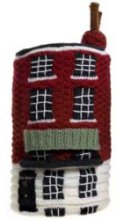

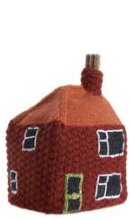
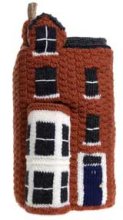
Take, for instance, the centerpiece of her 2002 solo show, Cosy. This is a series of beautifully hand knit tea cosies, shaped like little houses, which look as though they could be lifted to reveal something really nice – a pretty china teapot, perhaps. The piece is entitled, Knitted Homes of Crime, and the tea cosies are representations of either the British homes of women who have killed, or the houses in which they have killed. “I’ve always been obsessed with murder and what makes people feel they could kill, when for most of us that sort of behavior is so outside the moral code,” she explains.
Created to explore themes of nurturance, as well as challenge society’s expectations of women, the piece also works to destabilize notions of home as a non-threatening bastion of domesticity, and knitting as a cosy and comfortable pastime. “You expect tea cosies to be lovely charming things, in the way that society expects women to always be nurturing. I wanted the tea cosies first to lull, then to shock, because it is always seen as more shocking when a woman kills,” she explains. “Society judges women much more harshly when they commit murder, than it does men. It’s not okay for men to kill, but it’s really not okay for women.”

While some of Freddie’s pieces are designed to disturb, in others she simply plays with words and images to create visual puns. “The titles of my work are very important,” she says. Her playful, and perhaps slightly bent sense of humor is evident in Legroom, a sweater with arms that end in sock shapes, and Tree Cosies, a series of tubular sweaters for trees. Whether she is creating impossible-to-wear garments such Anyway – a series of interconnected, four-limbed sweaters, that is to date her largest piece – or knitting a “glove” designed to cover a prosthetic arm, Freddie seeks to subvert accepted notions of art and craft. Her art, much like the museum of curiosities in which she lives, runs the gamut from the mischievous to the macabre. If art is suppose to challenge our perceptions, makes us feel something, and encourage us to look at the world in a different way, the knitted art of Freddie Robins succeeds on all counts.
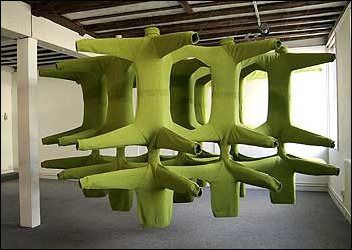
Originally published in Interweave Knits Magazine, Spring 2004. Images courtesy of Freddie Robins. Unauthorized use of text or images is prohibited.

I’M A MATURE STUDENT (58 AND COUNTING!), DOING A ART AND DESIGN FOUNDATION COURSE AT BURNLEY COLLEGE, PREVIOUS TO GOING TO PRESTON UNI. TO HOPEFULLY ACHIEVE MY BA IN THE SUBJECT. I FOUND THE WORK OF FREDDIE ROBINS ABSOLUTELY FASCINATING – OFTEN SUCH TWEE-LOOKING CREATIONS ON THE SURFACE AT TIMES, WITH REALLY FANTASTIC DARK UNDERTONES. I SMILED MY WAY THROUGH THE IMAGES. THE WEIRD THOUGHTS BEHIND THE ART REALLY INTRIGUED ME, AND I APPLAUD HER ORIGINALITY AND SKILL.